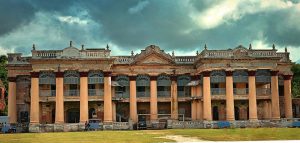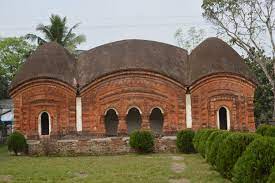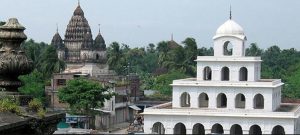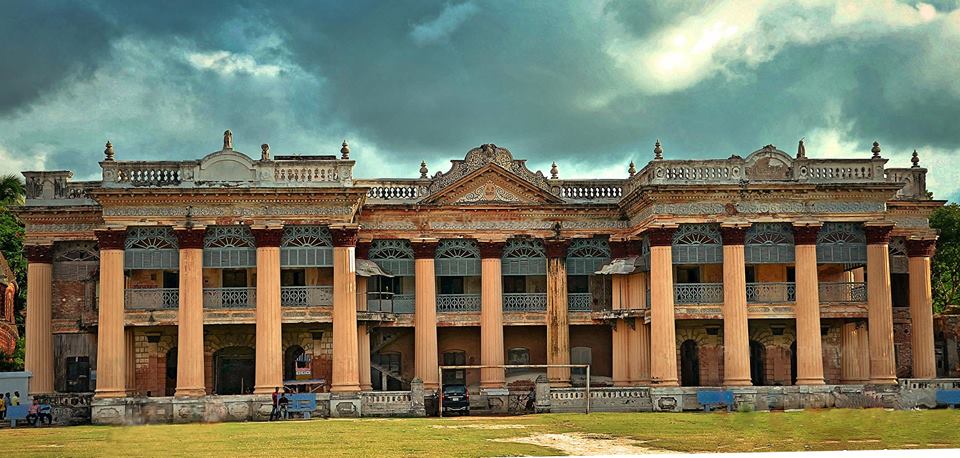Puthia Rajbari or Panchani Zamindarbari is the residence of Maharani Hemantakumari Devi. Puthia Rajbari in Rajshahi is one of the archaeological heritage of Bengal. In 1895, Maharani Hemantakumari Devi built the current two-storied rectangular palace in an attractive Indo-European style.

History
During the Mughal period in the 17th century, the Puthia zamindari was the oldest among the various kingdoms of Bengal. It is said that Nilambar came to be known as Puthia Rajbari after receiving the title of ‘Raja’ from Mughal Emperor Jahangir (1605-27 AD). In 1744 the zamindari was divided. In that division, the eldest son of the zamindar got five and a half annas of the property and the other three sons got three and a half annas. Till 1950 there was a zamindari system. When the custom disappeared, the zamindari of Puthia Rajbari also disappeared. But even though the zamindari was abolished, their palaces, temples and other structures built during that period still survive. This magnificent palace was built in 1895 by Maharani Hemanta Kumari-Devi in honor of her mother-in-law Maharani Sarat Sundari Devi.
Infrastructure
The pillars, ornamentation, woodwork, and floral and foliage paintings on the walls and doorways of the building bear the hallmarks of exquisite architectural style. The roof of the Rajbari is flat, iron beams, wooden beams, and tiles are used on the roof. Moats were dug around the palace for security.

Big Ahnika Temple
About 100 meters west of the Puthia Rajbari Lake, there are three temples side by side on the western side of the large pond of the Zamindar Bari. Among these, the southernmost temple is known as Charani Bara Ahnik. The entrance to the three-roomed temple, built on a long rectangular plan in a north-south direction, is on the east side. The roof of the middle room of this temple is built in the dochala style. The side rooms are two square and covered by four-pitched roofs. The front wall on the eastern side of the temple is decorated with various types of terracotta plaque images. Based on the layout, the temple is believed to have been built in the 17th/18th century AD.
There are 6 Rajdighis around Puthia Rajbari. The area of each dighi is 6 acres. There are also six temples. The biggest Shiva temple. Besides, there are beautiful terracotta plaques on the walls of each temple like Radha Govinda Mandir, Gopal Mandir, Govinda Mandir, Dolmancha etc. Beautiful terracotta plaques on the walls of every temple. Jorbangla temple, Banglo temple, Pancharatna i.e. pinnacled temple i.e. temples of different styles of Bengal are all interesting. Apart from this, the bathing ghat of the queen, the large palace courtyard with the inner quarters.

Puthia Govinda Temple
Govinda Mandir is located in the courtyard of Puthiya Panchani Zamindar Bari. Govinda Mandir is an important antiquity. The temple, founded on a high altar, is built on a square plan. There are numerous terracotta plaques in the temple. Apart from depicting Ramayana, Mahabharata, and mythology, pictures of fauna and flora are also presented through plaques. This temple is believed to have been built in the 18th century.

Puthia Dol Temple
Built on a square plan on both sides of the front yard of the Puthia Rajbari, the four-storied temple measures 21.54 meters on each side. The dol manch temple, made of lime and sand, is gradually getting smaller and higher. Above the fourth floor is the dome-shaped spire of the temple.

Adorned by finials at the top of the spire. Each floor has spacious terraced balconies. There are seven entrances in each arm on the ground floor, five on the second floor, three on the third floor, and one on each arm on the fourth floor. The height of this temple is 20 meters from the surrounding plain. The temple was built in the last decade of the 19th century by Hemanta Kumari Devi of the Panchani Zamindar bari of Puthia.

Most successful people already use Robot. Do you? https://Sab.frostyelk.se/gotodate/go
Good Information. Thanks
Very good article. I definitely appreciate this website. Continue the good work!
Thank you so much.
good
[…] শতকের শুরুতে নাটোর রাজবংশের উৎপত্তি হয়। ১৭০৬ সালে পরগণা […]